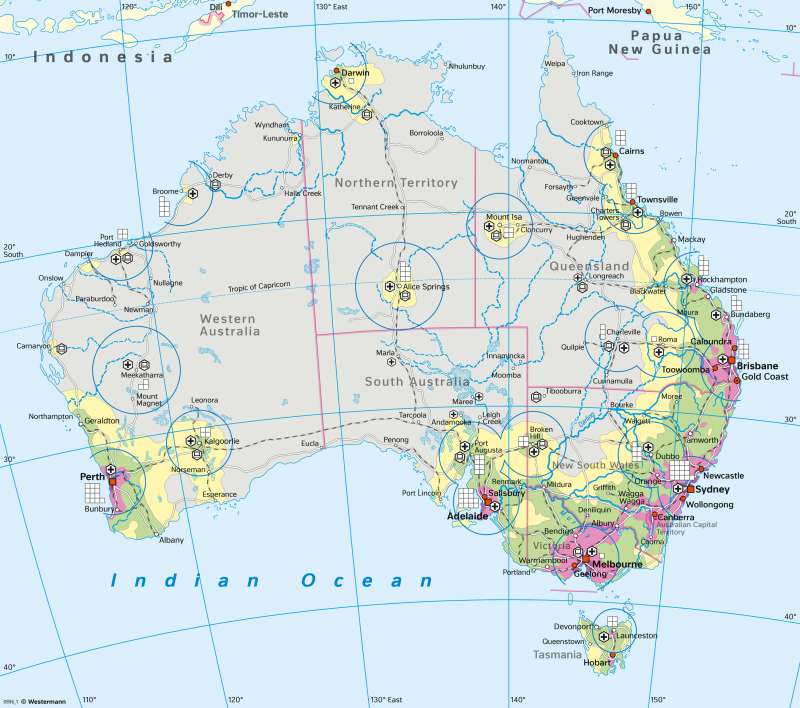Australia - Providing for the Outback
Hazardous environment
978-3-14-100890-6 | Page 167 | Ill. 4

Overview
Australia's population is extremely unevenly distributed. Almost two thirds of the 25 million people inhabit the urban areas along the coasts of Victoria, New South Wales, Queensland and South Australia and their hinterlands. In addition, there is another larger conurbation, Perth (2.1 million inhabitants), which is, however, spatially separated from other populated regions. The majority of Australia is made up of remote areas with regional supply centres (e.g. Alice Springs, Darwin) or almost uninhabited areas, which are referred to as the Outback.
The topic of the map is the supply of the Outback, which commonly takes up long distances and times and is sometimes only possible through good planning. Overall, the interior is very dependent on Australia's rural and urban areas for goods, medical services and educational services.
Infrastructure and transport
The transport of goods takes place mainly on the well-developed national highways (major roads), which reach many of the populated areas outside the deserts of Western and South Australia. These are used, for example, to transport agricultural products from the rural areas to the more remote regions.
Medical services
Medical services are provided by the famous Royal Flying Doctors Service. This is a non-profit organisation that uses its 77 aircrafts to bring medicine or, if needed, doctors or nurses to the remote areas. Sydney, Melbourne, Adelaide, Alice Springs and Brisbane are the most important bases of the RFDS. For example, 800 RFDS flights originate from Sydney in one year.
Author:
Christoph Zwissler
Medical services
Medical services are provided by the famous Royal Flying Doctors Service. This is a non-profit organisation that uses its 77 aircrafts to bring medicine or, if needed, doctors or nurses to the remote areas. Sydney, Melbourne, Adelaide, Alice Springs and Brisbane are the most important bases of the RFDS. For example, 800 RFDS flights originated from Sydney in one year.
Education
School education is very hard to implement in the Outback. This is because the predominant forms of settlement are cattle stations and very small towns with only few inhabitants. So in many communities the population is so small and the distances between stations so big that it is not possible to run a school.
This is what the School of the Air does. It teaches children in the Outback through online lessons. The programme started in 1951 in Alice Springs, transmitting educational programmes via radio. Nowadays, the students receive about 1 hour a day online education with a teacher and their class. For many children it is an important opportunity to see other kids from their region.
School of the Air programmes exist in all of Australia’s states except Tasmania and are organised by correspondence schools which the children in the Outback are assigned to. Apart from a correspondence school in Sydney, these schools are located in the regional centres that have less than 100,000 inhabitants, e.g. Meekatharra, Mount Isa and Charleville.
With the great effort made by e.g. the School of the Air and the RFDS, Australia manages to provide necessary services even in the most remote areas.
Author:
Christoph Zwissler




